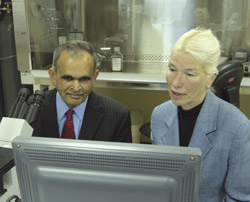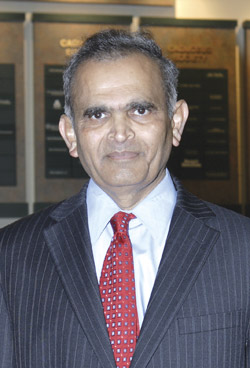
Whether you know it or not, medical research plays a significant role in the Peoria community, both in terms of healthy living and economic development. It strengthens the community by providing patients with doctors familiar with the most recent findings concerning diseases, treatments and technology. It brings doctors, researchers and medical students to the area. It adds major dollars to the local economy.
Dr. James Graumlich—associate professor of medicine and clinical pharmacology, and interim chair of the department of medicine—explained that many understand the role the University of Illinois College of Medicine at Peoria (UICOMP) plays in training physicians, but “fewer people recognize that UICOMP is an engine for economic development because it brings federal research dollars to central Illinois.” And it is only through such research that cures and treatments for diseases come about.
Dr. Jasti Rao, an internationally known medical researcher, holds several positions within UICOMP. As senior associate dean for research, he is responsible for furthering basic, translational and clinical research at the college. He also serves as head of the department of cancer biology and pharmacology, professor and director of the program of cancer biology, and professor of neurosurgery.
His passion for finding a cure for cancer and improving patients’ quality of life, and the fact that no cancer research was being done at UICOMP, were among the factors which motivated Dr. Rao to move to Peoria in 2001. “I like to take challenges and thought this was a better opportunity to establish a cancer research program in Peoria,” he said. “My brain tumor research in Houston was in a clinical setting, and I was interested in expanding into other areas of cancer research, such as lung, breast and other cancers. I was also interested in establishing my own department.”
But motivation alone isn’t enough for a medical research program to be successful. For that, said Dr. Rao, commitment from the organization and the surrounding community, in terms of financial and professional support, are needed. Dr. Stephen Lasley, professor of pharmacology and assistant head of the department of cancer biology and pharmacology, explains some additional needs. “The most important components are lab space—and possibly the necessary construction dollars—plus top-notch research investigators,” he said. “Technology will follow these components. In addition, a supportive research environment from the facility administration is critical.”
Benefits of Medical Research in Central Illinois
According to Dr. Rao, UICOMP is currently conducting cancer research, specifically on brain tumors (glioblastoma, meningioma, medulloblastoma, neuroblastoma); breast, lung and prostate cancers; and leukemia and melanoma. “Most of the research presently being carried on at UICOMP concerns cancer biology, investigating cellular/biological mechanisms underlying the disease and novel therapeutic approaches,” reported Dr. Lasley. “However, there are other studies going on concerning treatments for Alzheimer’s disease, alcoholism and attempts to understand the brain toxicity resulting from long-term exposure to metals [such as] lead and uranium.”
Some of Dr. Rao’s most recent work has had a significant impact on the cancer research field and has even led to the acquisition of a U.S. patent. His discovery of how to inhibit tumor formation and regress pre-formed tumors has proven to be extremely effective against the most common and deadliest form of primary brain cancer in animal models. According to a member of his staff, “These research discoveries should ultimately increase the ability to detect, monitor and treat the highly malignant cells that cause cancer-related deaths, and the potential exists for this patentable research technology to translate to the clinical application.”
Not only does such research provide benefits to society at large—advancing research innovations, improving drug discoveries and producing cures for debilitating diseases—it also provides many benefits to the local community. These benefits, as listed by Dr. Rao, are many:
- Establish a collaborative relationship between basic science researchers and clinical providers leading to improved knowledge for patient medical treatment.
- Active collaborative research and tissue core facility to further investigate and improve treatment of patients. (Example: collaborative efforts with stem cell research to augment the search for cancer cures.)
- Attract emerging cancer treatment technology and renowned cancer researchers to Peoria.
- Invite renowned speakers to Peoria, thereby benefitting all faculty (healthcare providers/research scientists) and enhancing our image in Peoria and beyond.
- Training of postdoctoral fellows, clinical fellows, residents, medical students and graduate students to assist with the development of an academic medical center.
- Generate more grant or contract revenue every year.
- Collaborate with pharmaceutical companies to generate more revenue.
- Enhance prestige and visibility through publications and presentations at national/international scientific meetings.
- Pioneer translation of laboratory findings to clinical trials to generate more revenue.
- Service on scientific advisory boards, study sections (National Institutes of Health) and membership on national/international committees to enhance our image on a worldwide level.
- Set standards for the use of quality-of-life measures for clinical trial outcomes, and establish Peoria as a clinical site for the most advanced cancer treatment trials.
- Make Peoria’s medical centers some of the foremost cancer treatment facilities in the world.
- Recruitment of new faculty and research scientists provides economic benefits to the community.
In addition, Dr. Lasley pointed out that medical research provides jobs in the Peoria community. “This work benefits society at large by providing the broad bases for improvements in health care,” he explained. “Peoria is more directly affected by new jobs and the associated economic stimuli added to the community, and also by the funds invested in the campus by private/business sources.”
Determining Areas of Investigation
With up to 15 projects going on at any given time, the medical research component of his job takes up a large percentage of Dr. Rao’s time. Projects can last for a short duration—meaning several months—or up to several years. “Depending on the success of the project, some can last nearly the length of an investigator’s career,” said Dr. Lasley. “But most projects are packaged into units of time less than five years that correspond to the duration of funding of the award.”
Because grant money is typically the sole source of funding for medical research, it plays a critical role in determining which studies will be undertaken. Grant sources rigorously evaluate one’s past experience and expertise in a specific area of investigation. “Changes and trends in research funding determine areas of investigation that might present a better chance of funding, but they do not strictly dictate directions of research,” added Dr. Lasley. Dr. Rao focuses on projects with clinical relevance that have a high potential to lead to therapeutic trials—from “bench to bedside,” as he put it.
“Under the leadership of Dr. Sara Rusch,” reported Dr. Graumlich, “the College of Medicine faculty developed a portfolio of projects in health systems, services and outcomes research. Representative projects measured the value of health information technology. Other projects studied low health literacy to reduce disparities in health outcomes. These projects and others brought over $3 million in federal and state research funds to central Illinois.”
Success Through Teamwork 
It is clear that the 33 medical researchers at the University of Illinois College of Medicine at Peoria are driven by excellence and teamwork. Dr. Lasley, who has received extensive training to compete for research funds on the national level, explains that teamwork with colleagues is the most rewarding and fruitful work for a medical researcher. “Team-based projects merge different expertise and backgrounds,” he explained, “thereby producing a stronger capability to succeed by addressing more challenging scientific problems.”
With a targeted focus on cancer research, exemplified by plans for the construction of a 20,000-square-foot Cancer Research Center, the institution is sure to make great strides for patients and society alike. According to Dr. Graumlich, “Future projects at the College of Medicine will reach out to community partners. The goal will be to lead collaboration in health systems, health services and health outcomes research and improve access, quality and outcomes of health care for all inhabitants of central Illinois.” iBi

